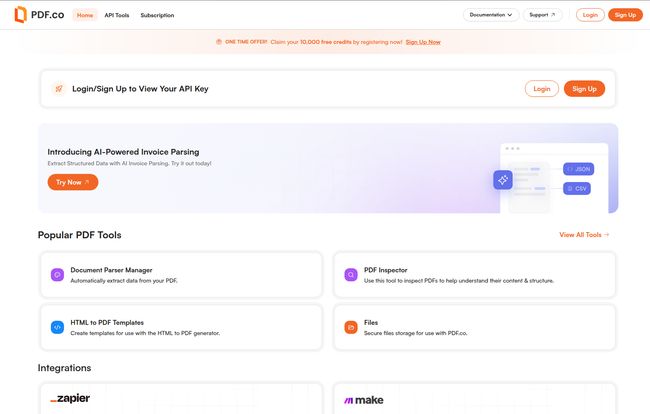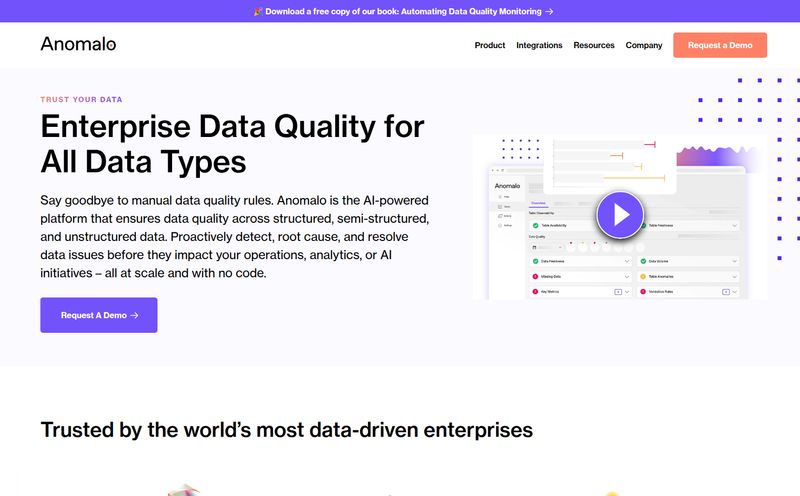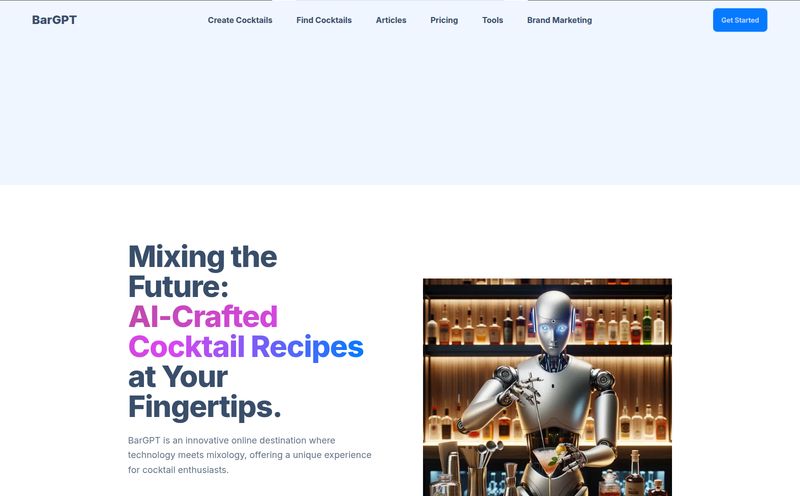Let’s have a little chat about PDFs. You know, the file format we all love to hate. It’s the digital equivalent of laminating a piece of paper—sure, it looks professional and it's universal, but the moment you need to get information out of it? Good luck. For years, my workflow for handling invoices, reports, or any kind of scanned document felt like a digital arts and crafts project: copy, paste, reformat, curse, repeat.
I’ve seen dozens of tools that promise to solve this. Desktop apps, clunky enterprise software, you name it. Most of them are either too simple or require a team of developers to even look at. So when I stumbled upon PDF.co, I was skeptical. Another API promising to be the magic bullet? Okay, sure. But I’ve been playing around with it for a while now, and I have to say… I’m genuinely impressed. This might just be the Swiss Army knife for document automation we’ve all been waiting for.
So, What Exactly Is PDF.co?
Alright, cutting through the marketing jargon, PDF.co is a Web API. Think of it as a set of powerful tools that live on the internet, ready to be called into action. Instead of installing a program on your computer, you send a document to their API, tell it what to do, and it sends the result back. It’s built for developers who need to integrate PDF manipulation into their apps, but—and this is the cool part—it’s also built for people like me, the automation nerds who live in platforms like Zapier and Make.
It’s a low-code approach to a high-code problem. You don't need to be a programming wizard to make it work. It's designed to automate all the tedious PDF tasks that suck hours out of your day: pulling data from invoices, converting files, splitting a 100-page report into individual chapters, you get the idea.
The Features That Actually Matter
A feature list is just a list until you see how it solves a real problem. And PDF.co has some features that are serious problem-solvers.
AI-Powered Invoice Parsing: The Real Star of the Show
This is the one that made me sit up and pay attention. If you've ever had to manually enter data from 50 different invoices, each with a slightly different layout, you know the soul-crushing boredom I'm talking about. PDF.co’s AI-powered parser is a game-changer. You throw an invoice at it, and it doesn't just OCR the text; it understands it. It intelligently identifies and extracts structured data like invoice number, company name, line items, and totals, then hands it to you in a neat little package (like JSON or CSV). This isn't just saving time, it's eliminating a whole category of human error.
More Than Just an Extractor
While the invoice parsing is brilliant, it’s not a one-trick pony. The platform is packed with other incredibly useful tools. You can convert PDFs to almost anything—Text, HTML, JPG, you name it. You can edit documents on the fly, adding text or images. You can merge multiple PDFs into one or split one into many. The PDF Inspector is a neat little diagnostic tool to understand the structure of a complex PDF, and the Document Parser Manager lets you create custom templates for extracting data from specific, recurring document layouts. It's a comprehensive toolkit.

Visit PDF.co
From HTML to PDF in a Snap
Another feature I find myself using more than I expected is the HTML to PDF generator. Need to create a professional-looking report or invoice from raw data in your system? Just build a simple HTML template, send it to the API, and poof—you get a perfectly formatted PDF back. It’s fantastic for generating dynamic documents automatically.
Who Is This For? Developers, Automators, and… You?
I see two main groups of people falling in love with PDF.co.
First, the developers. The API is well-documented, follows REST principles, and they provide a Postman collection right on the homepage to get you started immediately. With code samples in popular languages like JavaScript, PHP, and Python, you can plug this into an existing application without a massive headache. All requests are secured with HTTPS, which is a baseline requirement these days, but it's good to see it prioritized.
Second, and perhaps more importantly for the broader business world, are the low-code/no-code automators. The native integrations with Zapier and Make (formerly Integromat) are huge. This means anyone who can build a simple workflow can now incorporate enterprise-level document processing. Imagine a workflow: a new invoice arrives in your Gmail, Zapier grabs the attachment, sends it to PDF.co to extract the data, and then adds a new row to your Google Sheet and creates a bill in QuickBooks. All without writing a single line of code. That’s powerful stuff.
Let's Talk Money: The PDF.co Pricing Breakdown
Ah, pricing. The part where most API platforms get confusing. PDF.co uses a credit-based system, which I've always found to be a double-edged sword. But here, they do a pretty good job of making it transparent. Simple operations cost fewer credits than complex AI-powered ones. They even have a handy Credit Calculator on their pricing page to help you estimate your usage before you commit, which is a fantastic touch.
The plans themselves seem pretty reasonable:
- Basic: Starts at $8.99/month for 16,800 credits. Perfect for small-scale projects or just dipping your toes in.
- Personal: Jumps to $22.49/month for 37,000 credits.
- Business Plans: They have several tiers, starting from $44.99/month, offering a huge number of credits and more advanced features.
They also offer an annual plan that saves you a bit of cash. And the best part for newcomers? They offer a big chunk of free credits when you sign up, so you can actually try it out on a real project without pulling out your credit card. That shows confidence in their own product, which I always like to see.
What I Really Like About PDF.co
After all my testing, a few things really stand out. The sheer time-saving potential is obvious. Automating document processing just frees up so much brain space for more important work. The documentation is clear and the code samples are genuinely helpful, which isn't always the case. And for me, the seamless integration with Zapier and Make is the real clincher. It brings this powerful developer tool into the hands of business owners and operations managers. The transparent pricing and the credit calculator also get a big thumbs up from me—no one likes surprise bills.
A Few Things to Keep in Mind
Now, it's not perfect for everyone. This is an API-first platform. It's not a downloadable desktop app you can just double-click and run. While the Zapier integration makes it accessible, if you want to tap into its full power and integrate it deeply into a custom application, you or someone on your team will need some coding knowledge. It’s built on its API, so its power and its limitations are tied to that. If you're looking for a simple, offline PDF reader and editor, this aint it. This is an engine for automation.
Frequently Asked Questions about PDF.co
What happens if I run out of credits?
According to their FAQ, you can either upgrade your plan for more monthly credits or buy extra credit packs. They also have an option to enable automatic credit refills so your workflows don't suddenly stop working.
Can I cancel my subscription easily?
Yes, you can typically cancel subscriptions to services like this through your account dashboard. Based on their FAQ section, they seem to have a straightforward process for it.
How does the free trial work?
When you register, they give you a generous amount of free credits (the site says 10,000 as a one-time offer). This allows you to use the full API to test its functionality and see if it fits your needs before subscribing to a paid plan.
Is it hard to integrate with Zapier or Make?
Not at all. PDF.co is available as a pre-built app within both platforms. You just select it as a step in your workflow, connect your account with your API key, and choose the action you want to perform. It's very user-friendly.
What's the main difference between the business plans?
The main differences are the number of credits included per month and access to advanced features and higher priority support. Higher-tier plans are designed for businesses with significant document processing volume.
My Final Verdict on PDF.co
So, is PDF.co the magic bullet for all your PDF woes? For a huge number of automation-focused use cases, I’d say a resounding yes. It strikes a fantastic balance between raw developer power and low-code accessibility. It’s not a tool for casual, one-off PDF edits, but if you or your business regularly wrangles data from documents, it’s an absolute powerhouse.
It’s a tool that does one thing—document automation—and it does it exceptionally well. By focusing on being a great API and integrating with the platforms people already use, PDF.co has carved out a really smart niche for itself. If you're tired of the copy-paste-reformat dance, I highly recommend giving their free trial a spin. You might be surprised at how much time you get back.



